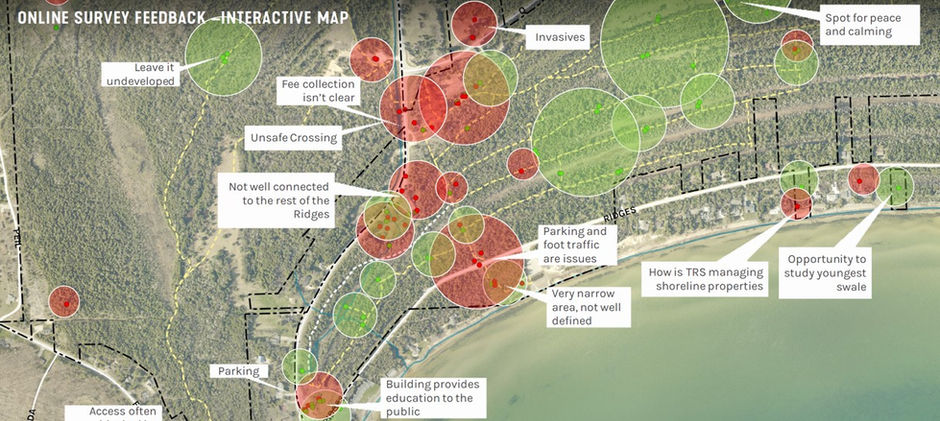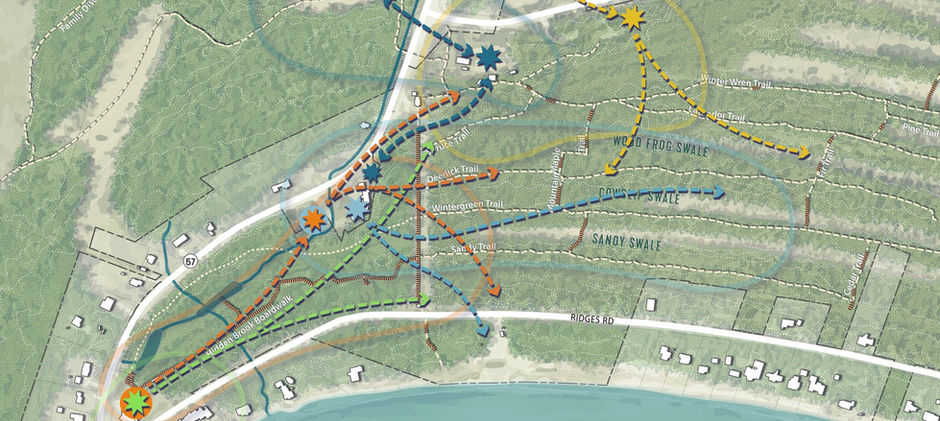Merit Award Winner
Project Name: The Ridges Sanctuary Master Plan
Location: Baileys Harbor, Wisconsin
Design Team: SmithGroup
For decades, The Ridges Sanctuary (TRS) has been committed to protecting the Sanctuary and inspiring others to conserve nature for future generations. Through educational experiences, land protection and ecological research, TRS has worked diligently to merge an impactful visitor experience with the preservation of one of the most biodiverse ecosystems in the Midwest. In 2021, TRS acted on a once in a lifetime opportunity to purchase Ridges Inn and Suites. Recognizing the magnitude of this undertaking, they knew their best path forward was one informed by their members, visitors, and community. They also recognized the need to focus on the strategic and sustainable growth of the organization, as demand for TRS programming has never been greater. With input from their Board, staff, members, donors, volunteers, and neighbors, they developed this plan as an inspirational roadmap outlining a vision for the next 20 years. At its core, the plan seeks to preserve The Ridges that members, visitors, and partners know and love, while allowing for changes to buildings and programs to sustainably grow the organization. This plan serves as a comprehensive blueprint for the future and ensures they continue to deliver on their mission.
The Ridges Sanctuary is one of the most ecologically diverse and fragile environments in the country, benefiting from the integrated expertise and sensitivity of landscape architects and ecologists. The consultant team’s principal-in-charge, project manager, and lead technical team were all landscape architects. All public engagement, inventory and analysis, design, and final documents were led and coordinated by landscape architects. This continues the tradition of LA leadership dating back to one of the organization’s founding members Jens Jensen. It was an honor and unique challenge to follow in such storied LA footprints our team did not take lightly.
The Ridges Sanctuary is at a critical inflection point in its 86-year history. Their founders, including famed landscape architect Jens Jensen, laid a solid foundation from which they have been building upon for decades. In 1941, just four years after the formation of The Ridges, Jensen wrote to approximately two hundred members, "The Ridges Sanctuary is passing through its first crisis, that of making its true purpose understood." In many ways they are exploring that very same question today - what is the purpose of The Ridges? The Ridges Sanctuary is grounded by three historic pillars of preservation, education, and research that date back to its original founders. In 2022, embracing the above challenges, The Ridges began the first comprehensive master plan in its 85-year history to affirm these values and adapt towards a more resilient future.
There were several special factors that made this process unique, challenging and rewarding:
-
The 1,600-acre study area was massive, ecologically diverse, and spread across Door County, encompassing the entire Ridges Sanctuary property extents at both the Baileys Harbor and Logan Creek locations.
-
It was critical to deploy an inclusive and transparent process with the flexibility to engage participants that were both locally based and regionally dispersed, sometimes varying by season considering Door County’s population and tourism dynamics. Further, TRS stakeholders and partners varied greatly depending on their focus on the individual mission pillars of research, education, and preservation, and required a nuanced approach to listen and share ideas with them. Door County’s tourism calendar posed unique process challenges and opportunities. Important engagement activities and milestones were carefully aligned with scheduled Ridges events and local programs during the primary tourist months, including the Festival of Nature, educational camps, and the annual member meeting. This maximized in-person engagement, especially for early site-based tours and on-site visioning.
-
To meet climate impacts that have and will continue to occur, the plan includes a Climate Resiliency Plan, which acknowledges the risks that climate change poses to the unique boreal habitat of the Sanctuary, identifies specific current and future vulnerabilities, and lays out strategies to mitigate impacts on biodiversity while also reducing the energy use and embodied carbon of their constructed facilities.
-
A key feature of this 20-year master plan is its comprehensive nature. To support the capital improvements identified throughout the plan, we knew we needed to establish a robust outline for ongoing management of the Sanctuary. We developed five important plans focusing on land management, business operations, marketing and communications, strategic action, and climate resiliency.











